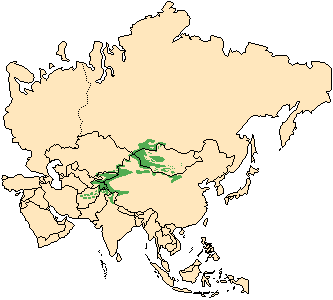![]() Return
to Artiodactyla
Return
to Artiodactyla
Classification
|
 Capra sibirica
Capra sibirica
Siberian ibex
![]()
Taxonomy
 |
 |
 |
Click on the pictures above for a larger view of the
photographs
|
||
General Characteristics
Body Length: 130-165 cm / 4.3-5.5 ft.
Shoulder Height: 67-110 cm / 2.2-3.6 ft.
Tail Length: 10-18 cm / 4-7.2 in.
Weight: 35-130 kg / 77-286 lb.The coat colouration varies widely across this ibex's range. The general colour of the pelage is a light tan, with the undersides lighter. In winter, mature males become much darker, with varying patches of white on the neck and back. Both sexes have a dark beard beneath the chin, although it is much less pronounced in females. Unlike the Nubian and Walie ibexes, the Siberian ibex does not display the contrasting black and white markings on its legs. Both sexes carry horns, and while in females they are small and slightly arched towards the rear, in males they grow into massive arcs which curl over the back and may even loop back on themselves. A male's horns also have several large knobs on their frontal surface.
Ontogeny and Reproduction
Gestation Period: 155-180 days.
Young per Birth: 1 or 2, rarely 3.
Weaning: Gradual, without a sharp cutoff.
Sexual Maturity: At 1.5-2 years.
Life span: Up to 16 years.
Ecology and Behavior
Principally a diurnal animal, the Siberian ibex has alternating periods of resting and activity throughout the day. Although the Siberian ibex lives at high elevations, and often climb up to the vegetation line at 5,000 meters / 16,000 feet, as a rule they seek out lower slopes during the winter. These slopes are generally steep and southward facing, areas where snow has difficulty covering in large amounts over large stretches of time. However, when the snow cover is heavy, Siberian ibex must find food by pawing away at the snow with their forelegs in order to reach the vegetation concealed below. If threatened, Siberian ibex flee to steep, rocky cliffs.Family group: Maternal and bachelor herds.
Diet: Grasses, leaves and shoots of bushes and trees.
Main Predators: Wolf, snow leopard, lynx, wolverine, brown bear, fox, golden eagle, humans.
Distribution
Alpine meadows and crags in Central Asia.

Range Map (Compiled from Shackleton, 1997)
Conservation Status
The Siberian ibex is a common species.
Remarks
Ibex (Latin) a kind of goat, a chamois. Although named after Siberia, this ibex is found primarily in central Asia, giving it its other (although less common) name "Asiatic ibex". Capra (Latin) a she-goat. -icus (Latin) suffix meaning belonging to: "of Siberia".
Literature Cited
Hess, R. 1990. Siberian ibex (Capra ibex sibirica). In Grzimek's Encyclopedia of Mammals. Edited by S. P. Parker. New York: McGraw-Hill. Volume 5, pp.527-528.Shackleton, D. M. [Editor] and the IUCN/SSC Caprinae Specialist Group. 1997. Wild Sheep and Goats and their Relatives. Status Survey and Action Plan for Caprinae. IUCN: Gland, Switzerland and Cambridge, UK. pp. 172-193.
Wilson, D. E., and D. M. Reeder [editors]. 1993. Mammal Species of the World (Second Edition). Washington: Smithsonian Institution Press. Available online at http://nmnhwww.si.edu/msw/
Return to Artiodactyla

![]()
© Brent Huffman, www.ultimateungulate.com |
|
|